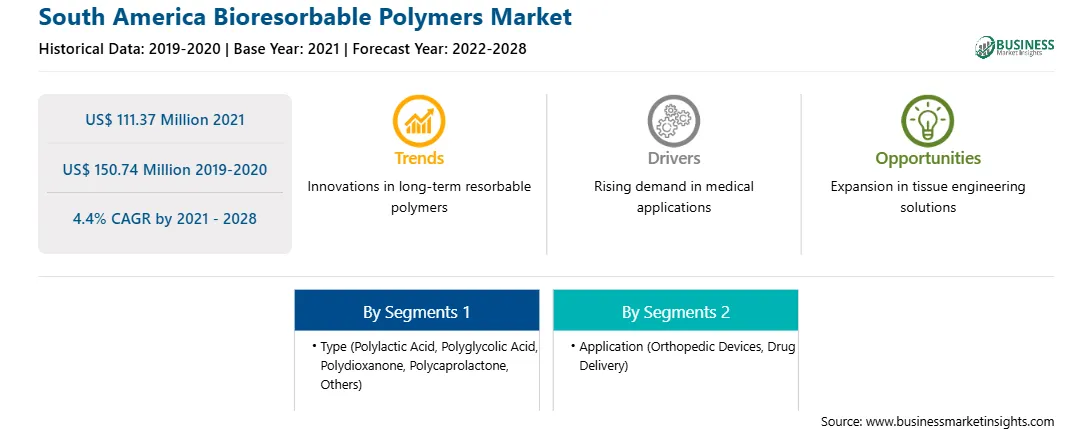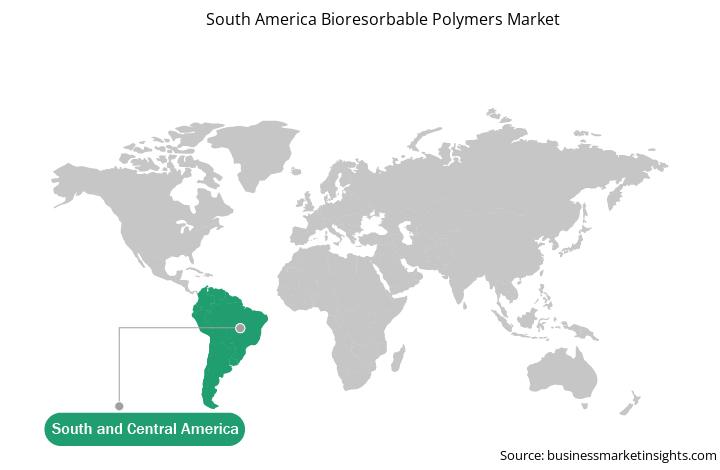The increasing demand for bioresorbable-based medical implants and wound dressing covers is driving the market growth. Bioresorbable polymers such as polylactic acid, polycaprolactone, and polydioxanone are widely used to manufacture screws, pins, rods, plates scaffolds, sutures, stents, and other medical implant devices. Furthermore, bioresorbable polymers are also used as controlled drug release implants inside the human body. Once the recovery of the patient's organ begins, these implants gradually start dissolving and are entirely absorbed in the body after the accomplishment of its job. As the body itself absorbs these bioresorbable implants, the patient does not require a second surgical intervention to remove them. Hence, the demand for bioresorbable polymer implants and controlled drug release devices is increasing. Their improved clinical outcomes and cost-effectiveness are also supporting the market. Further, bioresorbable polymers are witnessing a surge in their demand due to their increased applications for wound management. Bioresorbable-based synthetic polymer wraps are widely used for wound dressing and covering since they provide a barrier against bacterial penetration as well as oxygen permeability to the wound. The polymer is also used to manufacture bioresorbable wraps and sheets that are extremely thin, and transparent foils that hold tissue masses in place and facilitate post-surgery healing. In addition, bioresorbable polymer powders are used for dermal filler applications. Dermal fillers, also known as soft tissue fillers, are injected into the skin using a minor surgical procedure to plump thin lips, enhance shallow contours, soften facial creases, remove wrinkles, and improve scars’ appearance.
Brazil reported the highest number of COVID-19 cases in South America, followed by Argentina, Peru, Chile, and Ecuador. Governments of South American countries have taken several measures such as lockdowns, trade bans, and travel restrictions to protect their citizens and combat the spread of the disease. This directly influenced the growth of the bioresorbable polymers market due to significant disruptions in supply chains and temporary shutdown of the manufacturing base due to indefinite lockdowns and temporary quarantines. With the gradual relaxation in restrictions, the supply of bioresorbable polymers is expected to stabilize in the coming years, thereby supporting the bioresorbable polymer market in the region.
With the new features and technologies, vendors can attract new customers and expand their footprints in emerging markets. This factor is likely to drive the South America bioresorbable polymers market at a good CAGR during the forecast period.
South America Bioresorbable Polymers Market Segmentation
Strategic insights for the South America Bioresorbable Polymers provides data-driven analysis of the industry landscape, including current trends, key players, and regional nuances. These insights offer actionable recommendations, enabling readers to differentiate themselves from competitors by identifying untapped segments or developing unique value propositions. Leveraging data analytics, these insights help industry players anticipate the market shifts, whether investors, manufacturers, or other stakeholders. A future-oriented perspective is essential, helping stakeholders anticipate market shifts and position themselves for long-term success in this dynamic region. Ultimately, effective strategic insights empower readers to make informed decisions that drive profitability and achieve their business objectives within the market.

| Report Attribute | Details |
|---|---|
| Market size in 2021 | US$ 111.37 Million |
| Market Size by 2028 | US$ 150.74 Million |
| Global CAGR (2021 - 2028) | 4.4% |
| Historical Data | 2019-2020 |
| Forecast period | 2022-2028 |
| Segments Covered |
By Type
|
| Regions and Countries Covered | South and Central America
|
| Market leaders and key company profiles |
The geographic scope of the South America Bioresorbable Polymers refers to the specific areas in which a business operates and competes. Understanding local distinctions, such as diverse consumer preferences (e.g., demand for specific plug types or battery backup durations), varying economic conditions, and regulatory environments, is crucial for tailoring strategies to specific markets. Businesses can expand their reach by identifying underserved areas or adapting their offerings to meet local demands. A clear market focus allows for more effective resource allocation, targeted marketing campaigns, and better positioning against local competitors, ultimately driving growth in those targeted areas.

The South America Bioresorbable Polymers Market is valued at US$ 111.37 Million in 2021, it is projected to reach US$ 150.74 Million by 2028.
As per our report South America Bioresorbable Polymers Market, the market size is valued at US$ 111.37 Million in 2021, projecting it to reach US$ 150.74 Million by 2028. This translates to a CAGR of approximately 4.4% during the forecast period.
The South America Bioresorbable Polymers Market report typically cover these key segments-
The historic period, base year, and forecast period can vary slightly depending on the specific market research report. However, for the South America Bioresorbable Polymers Market report:
The South America Bioresorbable Polymers Market is populated by several key players, each contributing to its growth and innovation. Some of the major players include:
The South America Bioresorbable Polymers Market report is valuable for diverse stakeholders, including:
Essentially, anyone involved in or considering involvement in the South America Bioresorbable Polymers Market value chain can benefit from the information contained in a comprehensive market report.